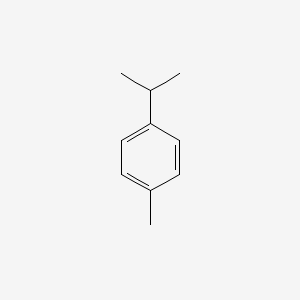| MeSH term | MeSH ID | Detail |
|---|---|---|
| Carbon Tetrachloride Poisoning | D002252 | 12 associated lipids |
| Dermatomycoses | D003881 | 17 associated lipids |
| Chemical and Drug Induced Liver Injury | D056486 | 39 associated lipids |
p-Cymene
P-cymene is a lipid of Prenol Lipids (PR) class. P-cymene is associated with abnormalities such as Abnormal shape. The involved functions are known as Binding (Molecular Function), inhibitors and Oxidation. P-cymene often locates in Cell membrane. The associated genes with p-Cymene are Chromatin, Homologous Gene and ethylbenzene dehydrogenase. The related lipids are Steroids.
Cross Reference
Introduction
To understand associated biological information of p-Cymene, we collected biological information of abnormalities, associated pathways, cellular/molecular locations, biological functions, related genes/proteins, lipids and common seen animal/experimental models with organized paragraphs from literatures.
What diseases are associated with p-Cymene?
p-Cymene is suspected in Abnormal shape and other diseases in descending order of the highest number of associated sentences.
Related references are mostly published in these journals:
| Disease | Cross reference | Weighted score | Related literature |
|---|
Possible diseases from mapped MeSH terms on references
We collected disease MeSH terms mapped to the references associated with p-Cymene
PubChem Associated disorders and diseases
What pathways are associated with p-Cymene
There are no associated biomedical information in the current reference collection.
PubChem Biomolecular Interactions and Pathways
Link to PubChem Biomolecular Interactions and PathwaysWhat cellular locations are associated with p-Cymene?
Visualization in cellular structure
Associated locations are in red color. Not associated locations are in black.
Related references are published most in these journals:
| Location | Cross reference | Weighted score | Related literatures |
|---|
What functions are associated with p-Cymene?
Related references are published most in these journals:
| Function | Cross reference | Weighted score | Related literatures |
|---|
What lipids are associated with p-Cymene?
Related references are published most in these journals:
| Lipid concept | Cross reference | Weighted score | Related literatures |
|---|
What genes are associated with p-Cymene?
Related references are published most in these journals:
| Gene | Cross reference | Weighted score | Related literatures |
|---|
What common seen animal models are associated with p-Cymene?
There are no associated biomedical information in the current reference collection.
NCBI Entrez Crosslinks
All references with p-Cymene
Download all related citations| Authors | Title | Published | Journal | PubMed Link |
|---|---|---|---|---|
| Pareek A et al. | Feverfew (Tanacetum parthenium L.): A systematic review. | 2011 | Pharmacogn Rev | pmid:22096324 |
| Verma RS et al. | Seasonal Variation in Essential Oil Content and Composition of Thyme, Thymus serpyllum L. Cultivated in Uttarakhand Hills. | 2011 | Indian J Pharm Sci | pmid:22303071 |
| Yones DA et al. | In vitro effects of some herbs used in Egyptian traditional medicine on viability of protoscolices of hydatid cysts. | 2011 | Korean J. Parasitol. | pmid:22072825 |
| Archana PR et al. | Modulation of gamma ray-induced genotoxic effect by thymol, a monoterpene phenol derivative of cymene. | 2011 | Integr Cancer Ther | pmid:21147817 |
| Schweinfurth D et al. | One-pot synthesis of symmetric and asymmetric p-quinone ligands and unprecedented substituent induced reactivity in their dinuclear ruthenium complexes. | 2011 | Inorg Chem | pmid:21214266 |
| Chu SS et al. | Composition of essential oil of Chinese Chenopodium ambrosioides and insecticidal activity against maize weevil, Sitophilus zeamais. | 2011 | Pest Manag. Sci. | pmid:21360645 |
| Jagadeesh RV et al. | A convenient and general ruthenium-catalyzed transfer hydrogenation of nitro- and azobenzenes. | 2011 | Chemistry | pmid:22113883 |
| Krstić M et al. | Synthesis, structural and spectroscopic characterization, in vitro cytotoxicity and in vivo activity as free radical scavengers of chlorido(p-cymene) complexes of ruthenium(II) containing N-alkylphenothiazines. | 2011 | Eur J Med Chem | pmid:21741132 |
| Barry NP et al. | Excellent correlation between drug release and portal size in metalla-cage drug-delivery systems. | 2011 | Chemistry | pmid:21735491 |
| Tian J et al. | Chemical composition and antifungal activity of essential oil from Cicuta virosa L. var. latisecta Celak. | 2011 | Int. J. Food Microbiol. | pmid:21320730 |
| González-Mas MC et al. | Comparative analysis of the volatile fraction of fruit juice from different Citrus species. | 2011 | PLoS ONE | pmid:21818287 |
| Silva CL et al. | Investigation of urinary volatile organic metabolites as potential cancer biomarkers by solid-phase microextraction in combination with gas chromatography-mass spectrometry. | 2011 | Br. J. Cancer | pmid:22085842 |
| Stepanenko IN et al. | Organometallic 3-(1H-benzimidazol-2-yl)-1H-pyrazolo[3,4-b]pyridines as potential anticancer agents. | 2011 | Inorg Chem | pmid:22032295 |
| Bisht S and Sisodia SS | Assessment of antidiabetic potential of Cinnamomum tamala leaves extract in streptozotocin induced diabetic rats. | 2011 | Indian J Pharmacol | pmid:22022005 |
| Koti BC et al. | Alcoholic leaf extract of Plectranthus amboinicus regulates carbohydrate metabolism in alloxan-induced diabetic rats. | 2011 | Indian J Pharmacol | pmid:21713092 |
| Verdeguer M et al. | Herbicidal activity of Peumus boldus and Drimys winterii essential oils from Chile. | 2011 | Molecules | pmid:21221059 |
| Stepanenko IN et al. | Conjugation of organoruthenium(II) 3-(1H-benzimidazol-2-yl)pyrazolo[3,4-b]pyridines and indolo[3,2-d]benzazepines to recombinant human serum albumin: a strategy to enhance cytotoxicity in cancer cells. | 2011 | Inorg Chem | pmid:22111668 |
| Courtiol E et al. | Reshaping of bulbar odor response by nasal flow rate in the rat. | 2011 | PLoS ONE | pmid:21298064 |
| Pandey SK and Kim KH | An evaluation of volatile compounds released from containers commonly used in circulation of sports beverages. | 2011 | Ecotoxicol. Environ. Saf. | pmid:20832862 |
| Hajhashemi V et al. | Antinociceptive and anti-inflammatory activities of Bunium persicum essential oil, hydroalcoholic and polyphenolic extracts in animal models. | 2011 | Pharm Biol | pmid:20942602 |
